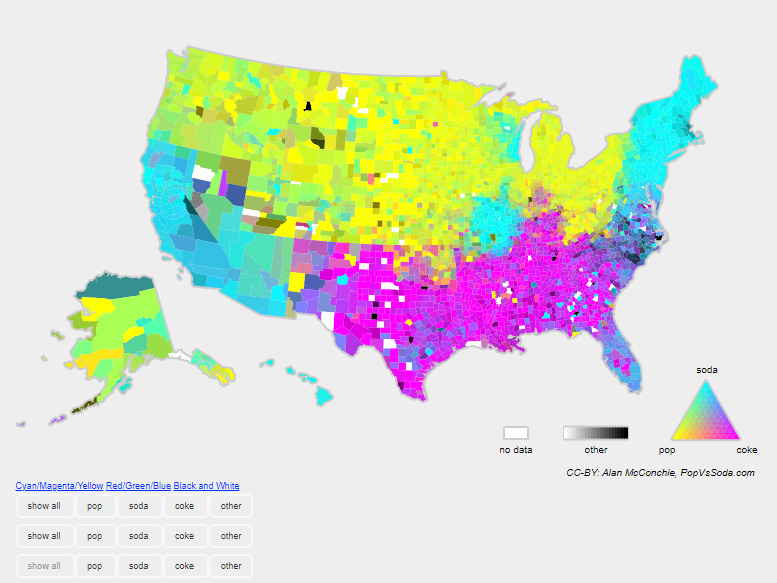In today’s globalized era, it is easier than ever for international cultural variances to be shared and celebrated. With the power of social media and other technologies, people with varying experiences and heritages can intermingle and learn from one another. This ability is critical for fostering empathy and tolerance, but also for offering a broader perspective. Despite this, it can be tough to truly understand the vastness and level of diversity that exists. One way to dive into cross-cultural examinations is to look at the language of the people. There are more than 7,000 languages spoken around the world and each one of these languages reflects the unique experiences, histories, and cultures of its native speakers. The effect that location, culture, heritage, and history have on language is perhaps best demonstrated by starting with familiar American English dialects and variations. By examining 7 words that vary from one region to the next, it is much simpler to understand the pivotal role that location—even within the same country—plays in language.
Table of Contents
1. Soda vs. Coke vs. Pop
Record Your Preference: The Pop vs. Soda Page (popvssoda.com)
The term used to describe soft drinks of all brands and varieties largely depends on where you are in the United States. If you’re in the northeastern states, you likely hear and use the term “soda”, but a quick trip down south and you’ll hear “coke”. To many, this term refers to the branded drink Coca-Cola, but Southerners apply the name to all varieties, regardless of whether they are referencing a ginger ale, an orange-flavored variety, or an actual Coca-Cola. This can be confusing to those from other regions as they believe they are being offered a Coca-Cola rather than a range of soft drinks in restaurants. Those who reside in the midwestern states, on the other hand, tend to use the term “pop” instead. This divided nature has captured the attention of many linguists who study American English dialects, and one organization even utilizes an interactive map to determine the prevalence of each term based on location.
2. Faucet vs. Spigot vs. Tap
Across most of the United States, the term “faucet” is preferred when referring to the portion of a sink that regulates water flow. Despite this, many who live in northeastern states, where there was a large prevalence of Dutch settlers, use the term “spigot” instead. This term closely resembles a word in the Dutch language known as “spijker” meaning “nail” in English. The term “tap” is also used in some areas in the Northeast, such as New England, and locations in the Midwest. Tap is also the most common term used in the British English dialect, which may explain this influence.
3. Lightning Bugs vs. Fireflies
Scientists around the world use the term “Lampyridae” to reference the family group of beetles with the ability to produce light through the production of chemicals in their abdomens. If you happen to be in the northern or western areas of the United States on a warm summer evening, you will hear locals excitedly mention the presence of “fireflies”. In the eastern states, however, you will instead note these insects are called “lightning bugs”. While everyone is familiar with both terminologies, the one that you opt to use will reveal a lot about the region you hail from to someone who is familiar with American English dialects.
4. Dinner vs. Supper
American English dialects for the most part lean on the word “dinner” for the larger meal that takes place in the evenings. In the Midwest and parts of the South, “supper” is preferred instead. The majority of people in Iowa, Kansas, Nebraska, Oklahoma, Mississippi, Arkansas, and Louisiana use the term regularly. This is another term that native American English speakers from all regions are familiar with and will understand, but it will indicate the region that the speaker hails from to those who use “dinner” instead. Non-native speakers may struggle to understand the use of the word “supper” if traveling to one of these areas for a short time. Another area of debate is whether there are any differences between a “dinner” and a “supper”. Some argue that a “supper” is a light meal that occurs earlier in the evening and is more casual in nature, while a “dinner” is a more formal occasion where a heartier dish is served later in the evening.
5. Carts vs. Buggies vs. Trolleys
Shopping carts go by various names around the world, including three common names in the U.S. The general term “cart” is applied in most regions and is understood throughout the country. If a person hailing from the northern U.S. ventured down south to do some shopping; they might be surprised to hear these wheeled devices referred to as “buggies”. The same is true of a Southerner visiting the West Coast, where the term “trolley” is utilized more frequently. While it may take a native speaker a moment to determine what is being referred to, American English dialects typically do not create large misunderstandings. Despite this, for businesses that want to connect with a local audience, the choice of “buggies” instead of “trolleys” in a business document or marketing campaign may resonate more and lead to a larger return on investment (ROI).
6. You All vs. Y’all vs. Youse
One of the most recognizable differences in word choices based on regional American English dialects is the use of “you all” versus the contraction “y’all” and “youse”. All of these refer to a plural form of “you” meaning a group of people. In most areas, “you all” is the optimal choice for native speakers, but in the south and some midwestern states, “y’all” is a hallmark of hospitality and charm. “Youse” is a unique choice that is local to some locations in New York and Pennsylvania but its use is not as widespread throughout the country as with the more formal “you all”. In either scenario, American English dialects are not always clear-cut. Because people have their own preferences and may hail from other parts of the country, it isn’t uncommon to hear all of these versions used in alternate regions.
7. Water Fountains vs. Drinking Fountains vs. Bubblers
Devices that provide a sanitary way to drink water in a public space are typically known as “water fountains” in American English. The alternative “drinking fountain” is used interchangeably and is based on personal preference more so than location. Individuals born and raised in Massachusetts, Maine, or Wisconsin are more likely to prefer the term “bubbler” to reference these fountains.
By examining American English dialects, it becomes apparent that a multitude of factors influence the way that people speak their native languages. In turn, language acts as a time capsule that preserves the heritage and history of a specific location. While the variations may not seem significant across the U.S., accents and vocabulary choices that are not in line with the region reveal a lot about the speaker. This is the case in languages across the world. For instance, a Spanish speaker in Northern Spain will sound a lot different than a Spanish speaker in Southern Spain. Because of these distinct and subtle nuances from one region to the next, it is crucial to use a translation service that is familiar with local dialects. In need of language translation services? Connect with subject matter expert linguists at ASTA-USA Translation Services by calling 1.866.446.1860 or inquire online.



